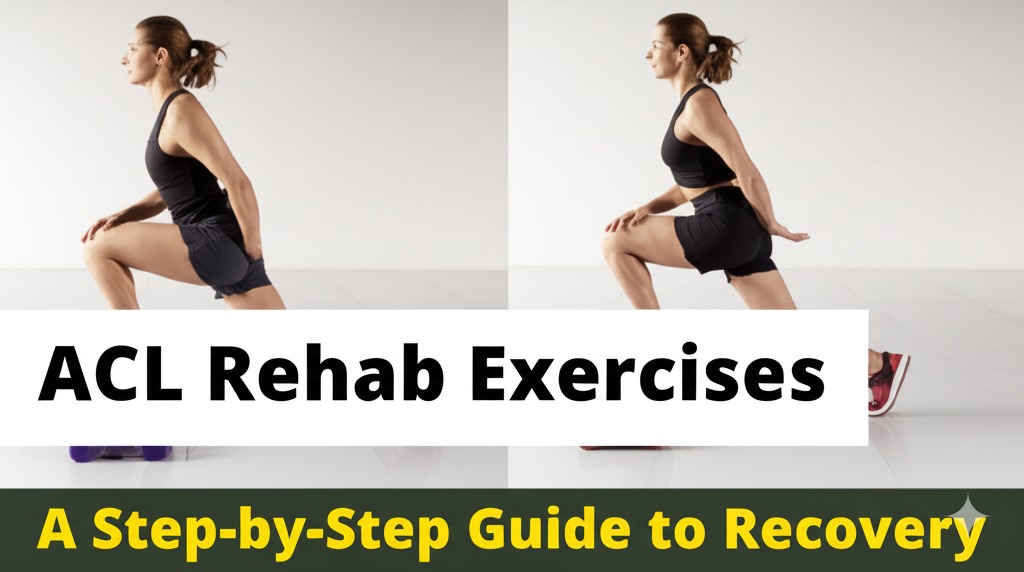Recovering from an ACL injury can feel like a long and challenging journey, but the right rehab exercises can make all the difference in getting you back to your active life. Whether you’re recovering from an ACL reconstruction or a partial tear, following a structured rehab plan is crucial for regaining strength, flexibility, and function in your knee. In this article, we’ll explore effective ACL rehab exercises to help you recover safely and efficiently.
Understanding the Importance of ACL Rehab
After an ACL injury, your knee’s stability, strength, and range of motion are compromised. Rehab exercises target these areas, focusing on improving strength, flexibility, balance, and functional movement patterns. Proper rehabilitation helps prevent further damage, reduces pain, and minimizes the risk of reinjury. A structured program can also prepare you for a return to sports or physical activity with confidence.
Key Stages of ACL Rehab
ACL rehab typically occurs in three distinct phases, each with its own set of goals and exercises. Let’s break down the stages of recovery:
Phase 1: Acute Phase (Weeks 1-2)
Goal: Reduce swelling and inflammation while maintaining mobility.
- Rest and Ice: Start by applying ice to the knee to manage swelling. Rest your knee, but avoid complete immobility.
- Quad Sets: Strengthen the quadriceps by contracting the muscle while your leg is extended.
- Straight Leg Raises: Work on lifting your leg without bending the knee to engage your quadriceps and hip muscles.
- Hamstring Sets: Gently activate your hamstrings by contracting the muscle while keeping the knee extended.
- Ankle Pumps: Increase circulation and reduce swelling with gentle ankle pumps.
These exercises help you regain initial movement and prevent stiffness in the knee joint.
Phase 2: Early Strengthening (Weeks 3-6)
Goal: Improve muscle strength and restore range of motion.
- Heel and Toe Raises: Stand with support and slowly raise your heels off the ground to strengthen calf muscles.
- Leg Presses: If approved by your doctor, use a leg press machine to work on your quadriceps and hamstrings.
- Step-Ups: Step up onto a low platform to enhance strength in your quads, hamstrings, and glutes.
- Bridges: Lie on your back with your knees bent, then raise your hips off the ground to activate your glutes and core.
At this stage, you’ll begin to incorporate more strengthening exercises to restore muscle function around the knee.
Phase 3: Advanced Strengthening & Return to Activity (Weeks 6-12)
Goal: Regain full function and prepare for sports or physical activity.
- Lunges: Perform forward and reverse lunges to build strength in your quads, hamstrings, and glutes.
- Leg Curls: Use a machine to strengthen the hamstrings and improve knee stability.
- Single-Leg Squats: Focus on performing squats on one leg to increase balance and strength.
- Jumping and Landing Drills: Practice jumping and landing techniques to prepare for impact activities.
In this phase, you’ll progressively challenge your knee with more dynamic exercises to regain your full range of motion and strength.
Exercises to Improve Flexibility and Balance
Flexibility and balance are just as important as strength during ACL rehab. These exercises help restore function and prevent reinjury:
- Hamstring Stretches: Use a towel to gently pull your leg toward your body while keeping the knee straight.
- Quadriceps Stretch: Stand and gently pull your heel toward your buttocks to stretch your quads.
- Standing Calf Stretch: Stretch your calves by placing one foot behind the other and pushing the back heel into the ground.
- Balance Training: Use a balance board or simply stand on one leg to improve proprioception and coordination.
Incorporating Low-Impact Exercises for Cardiovascular Health
As your knee heals, it’s essential to maintain cardiovascular fitness without putting undue stress on the joint. Low-impact exercises, such as swimming, cycling, and using an elliptical machine, can help you stay active without aggravating your knee.
- Swimming: The buoyancy of the water supports your body and reduces stress on the knee while allowing you to work on your cardiovascular endurance.
- Stationary Bike: Cycling on a stationary bike is an excellent way to build strength in your legs while minimizing impact.
- Elliptical Trainer: This machine provides a low-impact cardiovascular workout that engages the muscles of the legs without excessive knee strain.
The Role of Physical Therapy in ACL Rehab
While performing exercises at home is an essential part of ACL recovery, working with a physical therapist can significantly enhance your progress. A therapist can assess your unique situation, provide hands-on treatment, and tailor a rehab program specific to your needs. Physical therapy often includes techniques such as manual therapy, massage, and specialized exercises designed to improve strength, flexibility, and function.
Tips for Success in ACL Rehab
- Be Consistent: Stick to your rehab routine to ensure steady progress and prevent setbacks.
- Gradually Increase Intensity: Don’t rush your recovery. Gradually increase the difficulty and intensity of exercises to prevent overloading the knee.
- Listen to Your Body: If you experience pain (beyond mild discomfort), stop and consult your healthcare provider.
- Stay Patient: ACL recovery can take time, but with dedication and the right exercises, you’ll get back to full strength.
Conclusion: Take Control of Your Recovery
Recovering from an ACL injury takes time, but the right rehab exercises can speed up your recovery and help you regain your full strength and mobility. By following a structured rehab plan, focusing on key exercises, and working closely with a physical therapist, you can successfully return to your favorite activities and prevent future injuries. Stay consistent, stay patient, and remember that every step you take brings you closer to a full recovery.

Kallie Snyder is an author at Stonegate Health Rehab, providing valuable insights, recovery guidance, and rehab resources to help individuals achieve better health and well-being.
